Rebecca Barnatt-Smith
Rebecca is a freelance journalist and multi-media marketing executive, specialising in the future of social media marketing and immersive technology in business.
Read on to learn how to listen to your new target audience and create content that inspires as well as sells, with our 5 post-covid social media marketing tactics.
Covid-19 has changed the face of the marketing scene. With a post-pandemic population now relying on the digital high street, online communication and those ever-growing social platforms, experts have seen a peak in the number of online users since the beginning of the pandemic.
After over 76% of smartphone users reported spending extra time online since 2020, it’s time to take a step back and rethink your social strategy. With potentially more content consumers than ever before, it’s time to dust off those pre-pandemic content tactics and embrace the new future of social media marketing.
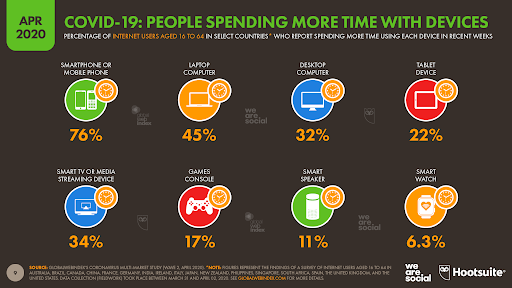
(Percentage of internet users aged 16-64 who report spending more time online during Covid-19, Source: Hootsuite)
From switching up your shareable content to revamping your brand’s voice and your paid social campaigns, it’s time to become a master of the post-pandemic marketing scene. Read on to learn how to listen to your new target audience and create content that inspires as well as sells, with our 5 post-Covid social media marketing tactics that will have you bossing your socials.
Behind every successful social media marketing campaign is a brand that knows its audience. The foundation for creating widely sharable content and socials that continue to rake in engagement, is a detailed understanding of your target demographic.
Has your target demographic potentially changed over the course of Covid-19? The answer is probably yes. The digital native audience has shifted as a whole since the onset of the pandemic after gaining more users and new platform niches than ever before. Not only are older generations being forced to switch to a new digital high street, but with new platforms such as TikTok making their way up to the top of the social platforms list, the type of content your audience engages with has changed too.
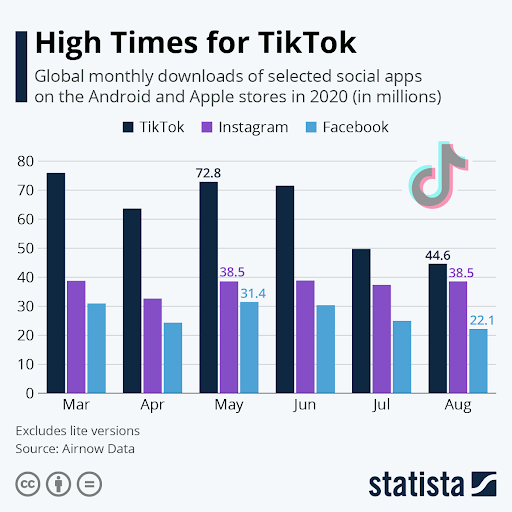
(Global monthly downloads of TikTok in 2020, Source: Statista)
As social platforms such as Instagram and TikTok take the lead, with over a 40% increase in daily users since 2020, the rise of video and image-based content engagement should be a key contributor to your post-pandemic content plan.
After research by Digital Commerce 360 revealed that customers are engaging with new platforms as a result of the pandemic, it’s time to take an audit of your post-Covid audience and work out where their engagement is strongest.
Using audience based analytic tools such as Google Analytics and Finteza is a great way to monitor platform engagement and gather a clearer picture of your general audience characteristics. Finding out whether you have a niche, older or younger following, will help determine which platform is most likely to produce successful results.
For many, Covid-19 has completely altered the world as they once knew it. With new Covid-driven changes transforming the future of business and the post-pandemic ‘customer’, marketers have had to alter their strategies to align with the newest topical trends.
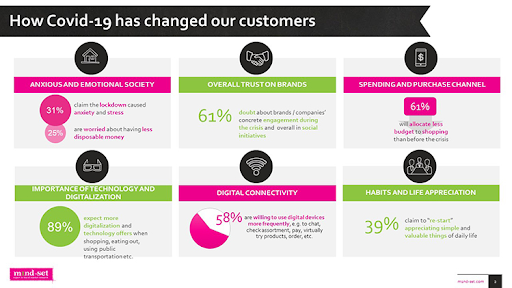
(How Covid-19 has changed our customers, source: Airport-Business)
If you want your social content to remain engaging, refreshing your brand’s core messages could be the key to success. For example, food and beverage related industries may need to focus on conveying accurate health and safety-related messages within their content.
Better still, incorporating empathy, adaptability and togetherness within your social content will encourage users to engage and connect with your brand throughout this difficult time.
Post-Covid posting doesn’t have to directly link to the sale of a product. Elongating your sales funnel and providing both educational, inspirational and shareable content for your consumers could boost your engagement while sales are low.
Use this time to build trust with your audience. Share community-based posts, and help customers look forward, rather than in the here and now.

(Source: IKEA)
IKEA provided a great example of this during their #StayHome Campaign. Rather than promoting their own products, IKEA’s strategy was to encourage consumers to cherish their own home and find strength within their own four walls. Connecting with their customers, and sharing inspirational content proved to be greatly effective, boosting trust and engagement across a multitude of platforms.
Influencer collaboration could also be key if you want to get your brand’s name into the public eye. Creating collaborative campaigns with opinion leaders who have large followings is a great way to boost your page engagement and brand awareness with minimal effort.
In fact, studies have shown that influencer marketing is performing better than ever before as a result of the Covid-19 pandemic. There has been a 75% increase in clicks on influencer #ad sponsored posts since March 2020 and this number is only set to rise.
Investing in sponsored campaigns and partnerships with celebrities and opinion influencers will build on the success of your e-Commerce sales and reach wide demographics at a much quicker pace.

(How effective is influencer marketing? Source: Smart Insights)
Over 80% of multi-media marketers have reported that influencer marketing has proved to be effective in building customer relationships and 89% have revealed that their ROI has been comparable if not better since investing in the strategy.
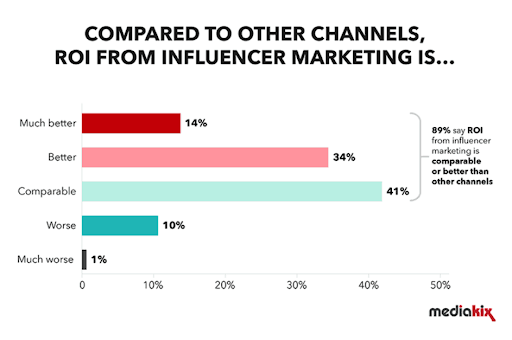
(Comparing the ROI for influencer marketing vs other channels, Source: Media Kix)
Especially during Covid conditions, influencer marketing has become a large part of an effective social campaign. In times of uncertainty, consumers are likely to rely on popular and trusted figures for advice and reassurance.
When directly linking this e-Commerce, consumers are more likely to purchase products from brands that have been recommended by their favourite opinion leaders, hence the effectiveness of this type of post-Covid strategy.
Once you have studied your demographic and found your niche, find the influencers leading the social trends relating to your brand and start smart marketing.
One major social media marketing trend we have seen since the onset of the pandemic is the reduction of paid social campaigns. After data from SocialBakers revealed that both cost per click and CPM had fallen as a result of the pandemic, marketers are quickly veering in new directions.
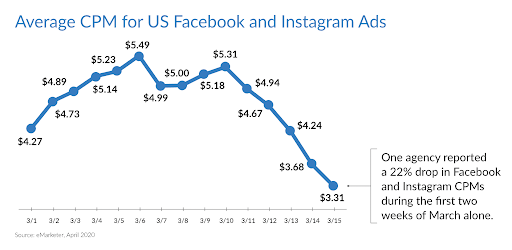
(Average CPM for social Ads in March 2020, source: eMarketer)
However, as the number of paid social campaigns decline in a time of brand and audience uncertainty, some experts suggest that this could be the perfect time to add a paid social campaign to your social media marketing strategy.
This may seem bonkers, but thanks to a reduction in paid social ads on the web, there is a 9% decrease in ad spend across Europe and less competition within your niches. If you’re looking to try something new or have money spare in the marketing budget, investing in a creative paid social campaign could set you apart from your competitors and could improve your brand awareness and retargeting strategy.
Better still, studies suggest that paid social will continue to rise post-pandemic as the high street continues to digitalise. As e-Commerce businesses find their feet post-Covid, it won’t be long until ad spend begins to skyrocket, so shoot now if you want to remain ahead of the game.
Developing an effective social media marketing strategy post-pandemic is not a straightforward journey to the top. As conditions across the globe continue to change on a daily basis, so will the marketing trends leading the future of online engagement and e-Commerce.
Whether you’re ready to revamp your entire strategy or simply incorporate one of our engagement boosting tactics into your social plan, remaining flexible, creative and Covid aware with your content strategy is the most effective way forward.
You’ll also receive some of our best posts today

Rebecca is a freelance journalist and multi-media marketing executive, specialising in the future of social media marketing and immersive technology in business.
Since you have clicked on this blog, it is...
In the ever-evolving realm of digital marketing, one concept...

User reviews are a game-changer for e-commerce. Consumers rely heavily o...
Don’t miss the new articles!